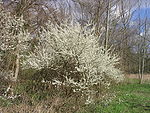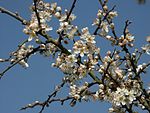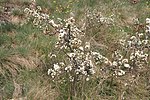Blackthorn
| Blackthorn | ||||||||||||
|---|---|---|---|---|---|---|---|---|---|---|---|---|

Fruiting sloes (early August) |
||||||||||||
| Systematics | ||||||||||||
|
||||||||||||
| Scientific name | ||||||||||||
| Prunus spinosa | ||||||||||||
| L. |
The Blackthorn ( Prunus spinosa ), also Schlehendorn , sloe , Sauer plum , Heckendorn , Schwarzdorn or German acacia called, is a species of the genus Prunus , which for tribes of stone fruits (Amygdaleae) within the family of Rosaceae belongs (Rosaceae).
etymology
The name of the sloe (from Middle High German slēhe ) is probably due to the color of its fruit and is derived from the Indo-European word (S) li , which means "bluish". In Old High German, the sloe was called sleha . The Slavic variants such as the Russian “Слива” (Sliwa) or the Serbo-Croatian “šljiva” (derived from: Slivovitz ) mean plum .
description
Vegetative characteristics
The deciduous, sparse and very thorny blackthorn grows as a shrub or as a small, often multi-stemmed tree that can live up to 40 years. It usually reaches heights of three meters. In rare cases, specimens up to six meters high can also be observed. Since the numerous short shoots protrude from the long shoots at almost a 90 ° angle , the sloe shows a typically heavily branched appearance. Flat-branched, bizarre cripple forms are created by game browsing or permanently strong winds and are particularly found in the oak bushes of the North Sea coast and the slopes of the Upper Rhine Rift.
The shallow-rooted sloe has a very dark, blackish bark that tears into narrow strips with advanced age. The bark of the shoots is red-brown in color and tomentose to finely haired, later they become bald. The branches show a rounded to angular shape and are covered with numerous short shoots. The short shoots develop thorns , which in the botanical sense are transformed side shoots and are interpreted as an adaptation to drought. Long shoots do not have a real terminal bud.
The 1.5 to 2 millimeters long, light brown buds usually stand in threes over a leaf scar, whereby the lateral ones are usually flower buds that are more rounded than the oval to oval-spherical leaf buds. At the end of the short shoots, flower buds often appear in clusters without internodes . The leaves are rolled in the bud position. The bud scales are usually hairy or ciliate and taper off at a point.
The leaves of the blackthorn stand on two to ten millimeter long petioles , which can be slightly hairy, but are usually glandless. The leaves are alternate and often arranged in tufts and spirals. They feel relatively soft. The leaf blade develops a length of two to five centimeters and a width between one and two centimeters. It has an obovate shape, which narrows in a wedge shape towards the base of the leaf and ends in a pointed to blunt tip. The leaf margin has double, fine perforation. Young leaves initially develop downy hairs on the underside of the leaf, then bald and then show a medium green color. The upper side of the leaf is hairless and dark green in color. Ruler stipules, serrated on the edge, usually protrude above the petiole. There are nectaries at the base of the leaf blade .
Generative characteristics
The blackthorn's white flowers appear in March and April - long before the leaves shoot. This makes it easy to distinguish the sloe from the hawthorn , the flowers of which are only formed after the leaves. The flowers standing on short, rigidly protruding, mostly bare pedicels are radial symmetry, five-fold and hermaphroditic. Their diameter is about 1.5 cm. They form on the thorny short shoots and are very close together, either individually or in pairs. Its light almond scent is characteristic. The flower cup is bell-shaped. The calyx consists of five triangular to oval sepals. They are about 1.5 to 2 mm long and have irregular fine teeth on the edge. The calyx is hairless on the outside. The oval, full-margined petals reach a length of about six to eight millimeters. They are not fused together and surround the approximately twenty five to seven millimeter long stamens with yellow or reddish anthers . These surround a single stylus . The medium-sized ovary is far sunk into the axle cup.
The inside of the flower cup secretes abundant nectar , so that the sloe is a valuable source of food for numerous insects in early spring. The sloe is pollinated by insects.
A spherical to slightly ellipsoidal, furrowed stone fruit with a diameter of 6 to 18 mm develops on an upright fruit stalk . It has blue-black frosting, hairs are not developed. The green pulp does not come off the stone core. The more or less double-pointed stone core has a spherical to lenticular shape. It is about nine millimeters long and six millimeters wide, is pockmarked, usually of a rough structure and with reticulated veins. From the dorsal furrow, inclined ridge lines go off. The pulp is initially very sour and tart - it only becomes tastier after it has been exposed to frost. The fruit ripens from October to November. As hibernators, the fruits stay on the bush through the winter. Animals that excrete the seeds of the fruit take over the spread.
The number of chromosomes is 2 n = 32, 16 or 48 in oat loin.
ecology
Root creep pioneer
The blackthorn is one of the root creeping pioneers. The far-reaching roots shoot saplings so that dense sloe hedges often form. Once established, the root brood can create impenetrable scrub. On pioneering sites, such as dry slopes, it quickly displaces the herbaceous vegetation that has settled there. From an ecological point of view, the blackthorn poses a problem for the conservation of such valuable and protected biotopes.
In locations that are characterized by extreme drought, such as rock slopes, the sloe often grows slowly and forms a crippled shape. Here it can exercise a protective function for animals and other plants.
Adjustments
Its long spines protect the blackthorn effectively from being eaten by larger herbivores ( megaherbivores ).
Synecology
The sloe is one of the most important wild shrubs for animals. It is considered a pronounced butterfly plant and, when it blooms in spring, is used by numerous butterflies, among others. a. the peacock butterfly , as a source of nectar.

Their leaves provide in particular for the caterpillars of the endangered gray Hardwood Dick body tensioner ( Lycia pomonaria ) and bushes Green tensioner ( Hemithea aestivaria ) or the highly endangered milkweed Small tensioner ( scopula umbelaria ) a valuable forage plant. The endangered eriogaster catax invests primarily its eggs in the sloe. The sloe leaves are the first food for the young caterpillars. The blackthorn also uses the sloe.
Several species of beetles are also dependent on the blackthorn as a source of food. The now rare golden rose beetle likes to nibble on the petals and pollen of the plant. One species of weevil , the sloe blossom prick ( Anthonomus rufus ), is the only Central European beetle species that lives exclusively on the sloe. The leaf beetles Clytra laeviuscula , Smaragdina salicina and Cryptocephalus chrysopus have been observed as leaf eaters on sloe . The larva of the longhorn beetle Phymatodes rufipes develops in the wood of the sloe . For around 20 species of wild bees , the blackthorn is a valuable pollen and nectar donor in early spring.
About 20 species of birds feed on the fruits of the blackthorn, including titmice and warblers . Sloe hedges offer an ideal habitat for shrub breeders in particular . This is used, for example, by the rare red- backed killer . He spears his prey such as insects or mice on the thorns of the sloe.
The blackthorn is attacked by the rust fungi Tranzschelia pruni-spinosae and probably also Tranzschelia discolor with uredia and telia . Two species from the genus Taphrina also parasitize on the blackthorn: Taphrina pruni forms fool's pockets on the fruits, while the very rare Taphrina insititiae causes adhesions on the shoots.
Distribution and location
The home of the blackthorn stretches across Europe , the Middle East to the Caucasus and North Africa . It is considered naturalized in North America and New Zealand. In the far north and on Iceland there are no records. It multiplies through sowing and root eruptions .
The blackthorn prefers sunny locations on paths and forest edges and rocky slopes or in bushes, on rather calcareous, often stony soils. It is widely used as a hedge plant . It is often found in the company of juniper , barberry , hazelnut , wild rose and hawthorn species . On the dunes by the Baltic Sea, it is particularly associated with willows. The blackthorn populates suitable locations from the plain up to altitudes of 1600 m.
Sloe bush societies are considered to be the link in the succession to the hornbeam, beech or oak forest. The sloe is a character species of the order Prunetalia in Central Europe, but also occurs in societies of the Alno-Ulmion or Carpinion associations.
The blackthorn is assigned to the Eurasian floral element . Numerous finds of sloe kernels in Neolithic wetland settlements show that it immigrated to Central Europe during the Neolithic period at the latest . In the pile dwelling village of Sipplingen on Lake Constance (layer 11, dendrochronologically dated around 3300 BC) there are perforated sloe kernels that were apparently worn as a chain.
Systematics
The blackthorn was in 1753 by Linnaeus under the currently valid name Prunus spinosa L. in his work Species Plantarum , Volume 1, p 475 firstdescribed . When synonyms are the terms Prunus acacia-germanica Crantz (1763), Prunus praecox Salisb. (1769) and Prunus montana Schur (1866) accepted. The sloe is an extremely variable species in terms of its characteristics, so that a systematic classification meets with difficulties. Hildemar Scholz and Ilse Scholz distinguish between two subspecies with regard to Vitkoskij . The main distinguishing feature is seen in the hairiness of the fruit stalk and the fruit cup.
- Prunus spinosa subsp. spinosa , common sloe. Synonyms are Prunus spinosa var. Vulgaris Ser. ex DC. (1825) and Prunus spinosa var.typica C. Schneider (1906). The common sloe grows bushy. Its branches form thorns and moderate hairiness. The young leaves are hairy, later they become bald. The fruit stalks and fruit cups are hairless. Their occurrences are widespread. In South Moravia there is a variety (var. Dulcescens Domin) that produces small, sweet fruits.
- Prunus spinosa subsp. dasyphylla (Schur) Domin (1945), Filzige Schlehe. The basionyma is Prunus spinosa var. Dasyphylla Schur (1866). The felty sloe grows as a thorny shrub or small tree. Their branches are hairy. The leaves develop permanent hairiness, at least on the underside. The stem and cup are hairy. The distribution area extends from south and south-west Europe through north-west Africa, Turkey, the Caucasus to north-west Iran. In the Pannonian region , South Moravia marks the limit of distribution.
- The systematic classification of the Haber or Haferschlehe , also called crawling , great sloe or sweet sloe , is made differently. On the one hand, it was named Prunus spinosa subsp. By Karel Domin and Werneck . fruticans (consecration) Nyman (1878) or Prunus spinosa var. macrocarpa as a descendant of an old cultural clan, which is related to Prunus spinosa , and therefore classified as a variety or subspecies of Prunus spinosa , on the other hand, Mang interprets them under the name Prunus x fruticans consecration as Hybrid between Prunus domestica subsp. insititia (the creeping plum or plum sloe ) and Prunus spinosa . The clan is difficult to distinguish from the real sloe. The oat sloe grows as a tree-like shrub two to three meters high. Thorns can only be found sporadically on older branches. The mostly hairy leaves are two to three centimeters wide and about five centimeters long and slightly wider than those of the sloe. Leaves and flowers shoot simultaneously. The flowers stand individually or in pairs and are loosely distributed over the branches. The spherical fruit measures around 12 to 25 millimeters in diameter, is black to blue-gray in color and contains an almost spherical and smooth stone core. The taste of the pulp is given as slightly acidic. The oat sloe is widespread in the area. It is unclear whether this is a wilderness, as it is used as a fruit tree and grafting base.
use
Medicine
The flowers, bark and fruits have an astringent ( astringent ), diuretic, weak laxative, antipyretic, stomach-tonic and anti-inflammatory effect . An infusion of flowers is particularly used in children with diarrhea, bladder and kidney problems and stomach problems. Sloe elixir is considered a suitable tonic after infectious diseases.
Food and beverages
The sloe fruits ripen from around September, but are mostly harvested on the bush after the first frost. By frost (Nature frost or freezing cold) a part of the bitter-tasting and astringent acting tannins enzymatically degraded in the fruit. The tannin content in the fruit juice drops from approx. 10 g / l to below 5 g / l. On the other hand, complete degradation of the tannins is undesirable because they contribute significantly to the taste of the products.
In the unripe state, the stone fruit z. B. like olives are pickled, when ripe it is used, for example, for the production of fruit juice and fruit wine as well as jam and as an additive to liqueur ( sloe liqueur or "sloe gin" , "sloe fire"), " sloe brandy " or " sloe spirit ".
Sloe wine is a fruit wine that is based only on the fruits of the blackthorn. In some areas, the fruits are also added to the cider in small quantities , which gives it a somewhat more wine-like character due to the tannins in the sloe fruits .
Engineering biology
The sloe attains biological engineering significance through its extensive roots, its ability to spread and its resistance to wind. It is therefore particularly suitable for fastening slopes and embankments. The sloe is also of some importance as a snow protection wood and traffic accompanying green. The bulky branches of the blackthorn are used to concentrate the brine in graduation towers , for example in Bad Salzuflen , Bad Orb or Bad Wilsnack .
Wood
The scattered-pored, slightly shiny wood of the sloe is characterized by its great hardness. It has a reddish sapwood and a brownish red core. It is used for carving and making whipsticks and walking sticks.
Historical
Sloe fruits were already collected in Central Europe in the Stone Age. Plant remains in spherical amphora ceramics or impressions of the cores on Neolithic clay pots are evidence of this. In the Middle Ages, ink was extracted from the bark . To do this, the bark had to be knocked off the branches and soaked in water. After three days, the water was poured off, boiled and poured over the bark again. This process was repeated until the bark was completely leached and all coloring substances had dissolved. Then the liquid was mixed with wine and boiled down. This thorn ink was used in the medieval scriptorias but was then forgotten. The red color obtained from the sloe bark was used to improve the shelf life of cheese. Sloe leaves served as a tobacco substitute. Sausage makers used the thorns of the sloe as plywood.
The seeds of the blackthorn contain the hydrogen cyanide glycoside amygdalin .
regional customs
The sloe used to be one of the plants that were used to predict harvest and weather. The days between the blooming of the sloe and April 23 - Georgi Day - were counted in order to determine the exact harvest date of the grain harvest around Jakobi Day (July 25). Popular belief is that the frequent occurrence of sloes meant a particularly harsh winter.
A strong protective effect against witches was ascribed to the thorn-rich wood . That is why pastures and farms were often planted with sloes.
Numerous legends deal with the early blooming, strikingly pure white flowers of the sloe. In Posen is reported that the cross thorn of blackthorn insinuated their branches for the crown of thorns Jesus to have provided. To reveal the innocence of the sloe, God poured countless white flowers over the bush at night.
photos
Blackthorn in the background as a typical plant in sun-exposed locations, in hedges and on the edges of forests. It contributes to a profuse spring aspect.
literature
- Kurt Harz : Trees and bushes, leaves, flowers, fruits of local species. BLV paperback, illustrated by Hellmut Hoffmann and Marlene Gemke. 12th edition. BLV, Munich 2005, ISBN 3-405-15107-4 .
Web links
- Blackthorn. In: FloraWeb.de.
- Profile and distribution map for Bavaria . In: Botanical Information Hub of Bavaria .
- Prunus spinosa L. In: Info Flora , the national data and information center for Swiss flora . Retrieved November 10, 2015.
- Distribution map worldwide.
- Thomas Meyer: Data sheet with identification key and photos at Flora-de: Flora von Deutschland (old name of the website: Flowers in Swabia )
- Hydrocyanic acid glycosides in the seeds of sloe.
Individual evidence
- ↑ Duden, the dictionary of origin. 1st edition. Dudenverlag, Mannheim, 2014.
- ↑ a b c d e f g h i j k l m Hildemar Scholz, Ilse Scholz: Prunus. In: H. Scholz (Hrsg.): Illustrated flora of Central Europe. Volume IV, Part 2B: Spermatophyta: Angiospermae: Dicotyledones 2 (3). 2nd Edition. Parey, Berlin / Hamburg 1994, ISBN 3-8263-2533-8 , pp. 495-500.
- ↑ a b Erich Oberdorfer : Plant-sociological excursion flora for Germany and neighboring areas. 8th edition. Verlag Eugen Ulmer, Stuttgart 2001, ISBN 3-8001-3131-5 , p. 575.
- ↑ Ruprecht Düll , Herfried Kutzelnigg : Pocket dictionary of plants in Germany. A botanical-ecological excursion companion to the most important species. 6th, completely revised edition. Quelle & Meyer, Wiebelsheim 2005, ISBN 3-494-01397-7 , p. 384.
- ↑ Butterfly plants. ( Memento from February 3, 2004 in the Internet Archive ) on: br-online.de , Bayerischer Rundfunk.
- ↑ BUND Schleswig Holstein ( Memento of October 7, 2007 in the Internet Archive ) (PDF; 243 kB).
- ↑ Peter Zwetko: The rust mushrooms Austria. Supplement and host-parasite directory to the 2nd edition of the Catalogus Florae Austriae, III. Part, Book 1, Uredinales. (PDF; 1.8 MB).
- ↑ Sven Gunnar Ryman, Ingmar Holmåsen: mushrooms. Bernhard Thalacker Verlag, Braunschweig 1992, ISBN 3-87815-043-1 .
- ↑ Martin Kolb: Culture change or culture break? Considerations on the transition from the Pfyner to the Horgen culture. In: Barbara Fritsch, Margot Maute, Irenäus Matuschik, Johannes Müller, Claus Wolf (eds.): Tradition and Innovation. Prehistoric archeology as a historical science. Festschrift for Christian Strahm (= International Archeology - Studia honoraria. Volume 3). 1998, ISBN 3-89646-383-7 , pp. 129-141.
- ↑ Species Plantarum. Volume 1, Lars Salvius, Stockholm 1753, p. 475 ( online ).
- ↑ Heinrich Marzell , Heinz Paul: Dictionary of German plant names. Volume III, Stuttgart / Wiesbaden 1977, p. 1117 (reprint: Cologne 2000).
- ^ W. Rothmaler: Excursion flora from Germany. 20th edition. Spektrum Akademischer Verlag, Heidelberg / Berlin 2011, ISBN 978-3-8274-1606-3 , p. 478.
- ↑ a b Info on sloe at Plants for a Future .
- ↑ Manfred Boksch: The practical book of medicinal plants. BLV-Verlag, ISBN 3-405-14937-1 , p. 228 f.
- ↑ Bärbel Schermer: The great Teubner kitchen practice. Gräfe and Unzer, 2008, p. 141.
- ^ Paul Arauner: Homemade wines and juices, liqueurs and schnapps . Falken, Niedernhausen 1985, ISBN 3-8068-0702-7 .
- ↑ Information on sloe wine ( Memento from May 22, 2008 in the Internet Archive )
- ↑ National Association of Horticultural Associations: Wish About the blackthorn .
- ↑ a b G. KF Stinglwagner , I. Haseder , R. Erlbeck: Das Kosmos Wald- und Forstlexikon. Kosmos, 2005, ISBN 3-440-10375-7 , p. 668.
- ^ Julius Kühn Institute: u. a. Properties of sloe .
- ↑ Sloe - the forgotten berry .
- ↑ Where the sloe gets its beautiful flowers from .













